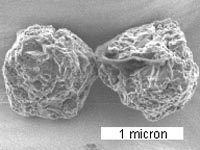Murchison meteorite
| Murchison | |
|---|---|

A Murchison meteorite specimen at the National Museum of Natural History (Washington)
|
|
| Type | Chondrite |
| Class | Carbonaceous chondrite |
| Group | CM2 |
| Composition | 22.13% total iron, 12% water |
| Shock stage | S1-2 |
| Country | Australia |
| Region | Victoria |
| Coordinates | 36°37′S 145°12′E / 36.617°S 145.200°ECoordinates: 36°37′S 145°12′E / 36.617°S 145.200°E |
| Observed fall | Yes |
| Fall date | 28 September 1969 |
| TKW | 100 kg |
 Pair of grains from the Murchison meteorite |
|
The Murchison meteorite is a large meteorite that fell to earth near Murchison, Victoria, in Australia, in 1969. It is one of the most studied meteorites due to its mass (>100 kg), the fact that it was an observed fall, and that it belongs to a group of meteorites rich in organic compounds.
On 28 September 1969 at about 10:58 local time, near the town of Murchison, Victoria, in Australia, a bright fireball was observed to separate into three fragments before disappearing, leaving a cloud of smoke. About 30 seconds later, a tremor was heard. Many fragments were found over an area larger than 13 km², with individual mass up to 7 kg; one, weighing 680 g, broke through a roof and fell in hay. The total collected mass exceeds 100 kg.
The meteorite belongs to the CM group of carbonaceous chondrites (see meteorite classification). Like most CM chondrites, Murchison is petrologic type 2, which means that it experienced extensive alteration by water-rich fluids on its parent body before falling to Earth. CM chondrites, together with the CI group, are rich in carbon and are among the most chemically primitive meteorites. Like other CM chondrites, Murchison contains abundant CAIs. Over 15 amino acids, some of the basic components of life, have been identified in the meteorite by multiple studies. All the amino acids found in the Murchison meteorite have been synthesized in laboratory experiments by the action of electric discharge on a mixture of methane, nitrogen, and water with traces of ammonia.
Murchison contains common amino acids such as glycine, alanine and glutamic acid as well as unusual ones like isovaline and pseudoleucine. A complex mixture of alkanes was isolated as well, similar to that found in the Miller–Urey experiment. Serine and threonine, usually considered to be earthly contaminants, were conspicuously absent in the samples. A specific family of amino acids called diamino acids was identified in the Murchison meteorite as well.
...
Wikipedia
